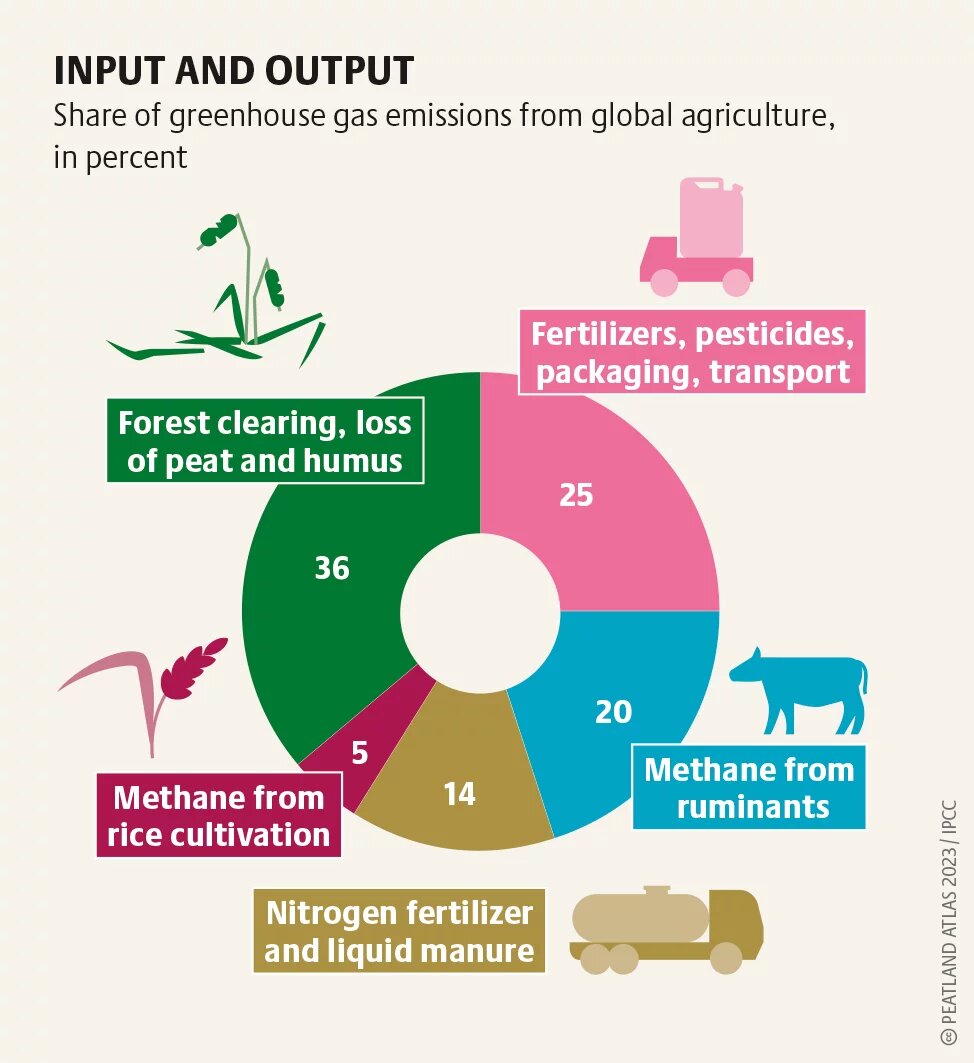
Our consumption of livestock products has an effect on the climate – through the emission of greenhouse gases and the conversion of natural landscapes into agricultural land. Even more greenhouse gases escape into the atmosphere when peatlands are drained to allow livestock-keeping or to grow fodder crops.

Half of all drained peatlands worldwide outside the tropics are now used for farming. In countries such as Germany and the Netherlands, the figure rises to almost three-quarters of all peatlands. Most are used for keeping livestock, especially as grassland for cattle. European peatlands and other wetlands have historically been used for animal husbandry involving the hand-mowing of fodder, the drying of hay or bedding in nearby higher and drier areas, and grazing on the drier margins of the peatlands. In other parts of the world, these forms of extensive wetland utilization are still common. In Kazakhstan and China, herders harvest fodder and bedding material and allow their animals to graze easily reachable reed beds. In the Flooding Pampa in Argentina or the Pantanal in Brazil, large-scale grazing takes place in wetlands that undergo alternating periods of drought and flooding. But overgrazing and degradation is often a severe problem, for example in Mongolia, where around 80 percent of the country's cattle are concentrated on peatlands.
While peatlands drained for farming are dominated by meadows and pastureland, they are also used as arable land to grow fodder crops such as silage maize. That requires draining, fertilizing and cultivating the land, which results in very high greenhouse gas emissions. Although peatlands occupy only around 3 percent of the agricultural area of the European Union, their drainage is responsible for 25 percent of the emissions from agriculture and agricultural land use.
Not only is arable farming harmful to the climate; but so is intensive grassland farming on drained peat soils. These areas are used to grow feed, for example for dairy cattle that require high-quality, energy-rich feed. The emissions of carbon dioxide (CO₂) and nitrous oxide (N₂O) caused by drainage can reach 20 to 50 tonnes per hectare per year on intensive grassland. On top of that the high-performance grasses, high fertilization rates and cutting frequencies of four or more mowings a year result in a monotonous, species-poor grassland. Peatlands are used for intensive dairy farming in north-western Germany, Finland, and especially the Netherlands. The city of Gouda, which gave its name to a world-famous type of Dutch cheese, is located in the centre of a peatland that was drained back in the 11th century.
Beef cattle farming can be slightly less harmful to the climate. Fodder quality requirements are lower than in dairy farming, and synergies with biodiversity objectives are possible. The extensive grazing with beef cattle, especially on non-peat soils, can maintain grassland habitats that harbour threatened plants and animals. Cattle eat what humans cannot digest, and so do not compete with us for nutrients. On peat soils, extensive grazing allows for reduced drainage. This can cut annual emissions to less than 20 tonnes of CO₂ per hectare. To preserve the peat and meet climate targets, however, high water levels are needed that cannot be achieved with such grazing. The ground would be too soft for common cattle breeds and the animals would sink into the mud. In addition, the cattle’s digestive system is less able to deal with feed from wet pastures, and hoof diseases and parasites such as liver flukes and lungworms are more of a problem. The actual carbon footprint of beef products varies, and depends heavily on the type of husbandry and the organic content of the soil. If cattle are kept on drained peat soils, the carbon balance includes not only their methane (CH₄) emissions but also the emissions due to peat degradation. In case of suckler cow husbandry, additional emissions of approximately 80 kilograms of CO₂-equivalent per kilogram of slaughter weight are calculated just for the rearing phase of the calves.
The consumption of meat and milk accounts for a large part of the greenhouse gas emissions attributable to the food system. The effects on the climate are much larger if the animals are kept on drained peat soils. Experts and environmental organisations therefore call for other more sustainable utilisation options for large peatlands. As soon as drained peatlands are rewetted – which is indispensable in order to meet climate targets–only the higher-lying parts are suitable for traditional, extensive grazing. Water buffaloes are an exception since they can also be kept in swampy areas. Around 95 percent of the world’s population of water buffaloes are kept in Asia, and especially in India, Pakistan and China. They are used for work in rice fields and for transport. Their meat and milk are an important food source for buffalo keeper in these countries. For Germany it was shown that herd management and marketing are much more demanding than with conventional cattle.
Many farms face major economic challenges in renouncing the use of peatlands. For these farms, paludiculture could offer an opportunity. This is a sustainable use of wet or rewetted peatlands. Plant species are cultivated that thrive on permanently waterlogged soils and that produce raw materials that can help decarbonize the economy. Using peatlands in this way enables a double transformation: the necessary withdrawal of livestock from rewetted peatlands meets the need for healthier, climate-friendly diets.


